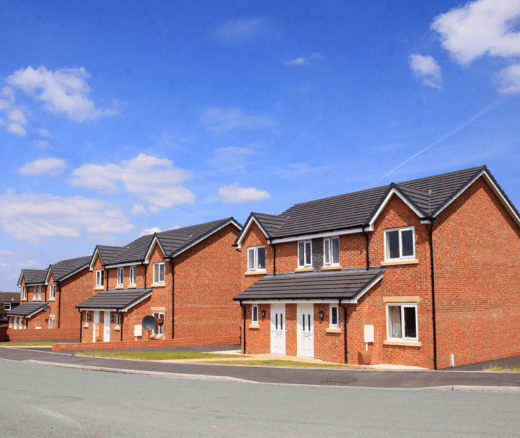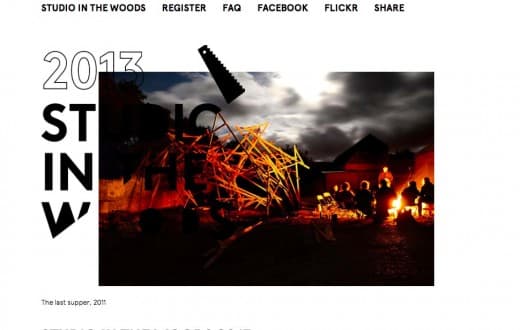 This year, Studio in the Woods promises to be better than ever – and places are subsided by Local Authority funding. We’re really excited about building permanent structures, on publicly accessible land owned by Swindon Council. See HERE for details
This year, Studio in the Woods promises to be better than ever – and places are subsided by Local Authority funding. We’re really excited about building permanent structures, on publicly accessible land owned by Swindon Council. See HERE for details
It’s Not About the Building…
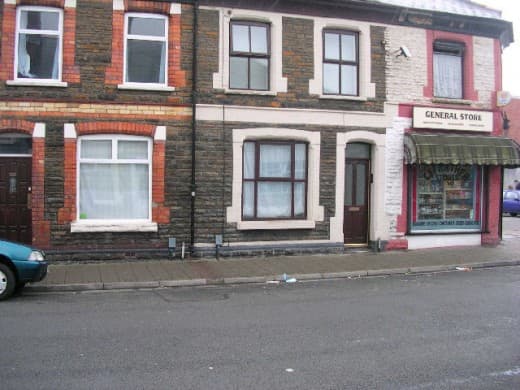 Above – Yup, that works for me.
Above – Yup, that works for me.
Without wanting to architects a disservice, we’re rather too fixated on the building. I’m realising, though, that in the important issues we face today – the development of our towns and cities – buildings are far less important than the spaces between. It sounds obvious when you say it, of course, but it’s still a point that many people seem not to realise.
In the criticism of the ubiquitous British developer housing, most people focus on how bad the buildings are. I’m not disputing for a minute that the buildings are anything other than appalling, cynical and lazy, but the main issue is one of site layout.
What I mean by this is that if you took the terrible architecture of the average British estate and rearranged it intelligently into a format where buildings formed street frontages, where the wasted space was removed, where the driveways were removed, where the spaces between buildings where reduced, where street widths were reduced, where blocks were formed with definition and hierarchy and corners contained shops and pubs, and there was a finer grain of pedestrian access across the area – you’d pretty much have the perfect place.
You could still have the terrible trappings of lazy developerdom – the pvc windows, the nasty brick and the horrible interlocking roof tiles – and it would be fine. All this, of course used to be second nature to us – as it’s pretty much the fabric of most towns across the UK, but it’s now a formula that alludes most house builders and developers. Are they just too stupid, too greedy, to lazy or just too conservative to think differently?
Housing – Same Again? No thanks
I’ve been thinking a great deal about housing recently, and Simon Jenkins’ article in the Guardian hit the nail on the head. I have no problem with Planning Minister Nick Boles’ call for 100,000 new houses every year – I just take issue with how and where he wants to build them. Boles wants to build more dim-witted low density car dependent housing estates, and his solution to finding land for them is not to add density and a finer grain to existing towns and villages or build on brown field sites (of which there are more than any point in history), but instead he proposes to free up Green Belt land for building.
It’s staggering that it hasn’t occurred to him that there might be a different way, or a better way. Staggering that he hasn’t realised how these banal land hungry estates delivered by lazy and risk averse developers are destroying much of the landscape of the UK. It’s curious that new ministers feel that they need to peddle a big and sound-bitey idea without having the foggiest idea what they’re talking about. We need to be far cleverer about where we build, and the mix, layout, density and zoning of new developments – yet far less protectionist about the actual buildings, where we should be encouraging huge diversity and individual freedom of expression.
Worryingly, local council members are often to blame for the poor quality of so many housing developments. We’ve had instances where they will not support higher density, lower cost housing schemes at planning – as they are under pressure from voters locally who perceive that this type of housing will devalue their own houses. Just one of the many reasons, I guess, that I’m not terribly in favour of the vacuous localism bill – as it will be one of the many things that ensures that housing doesn’t get better.
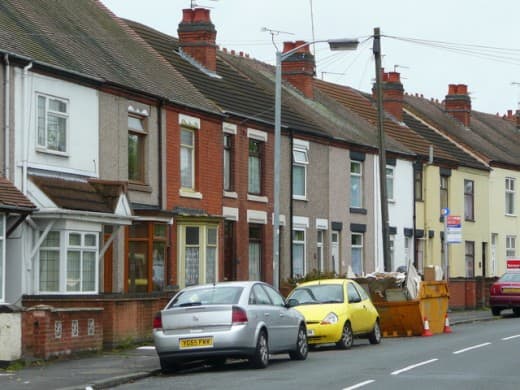 It really isn’t rocket science (above). We used to do it so well. The straightforward fabric of many British towns and cities – up to the point that developers decided they knew better.
It really isn’t rocket science (above). We used to do it so well. The straightforward fabric of many British towns and cities – up to the point that developers decided they knew better.
RIBA Regional Awards 2013
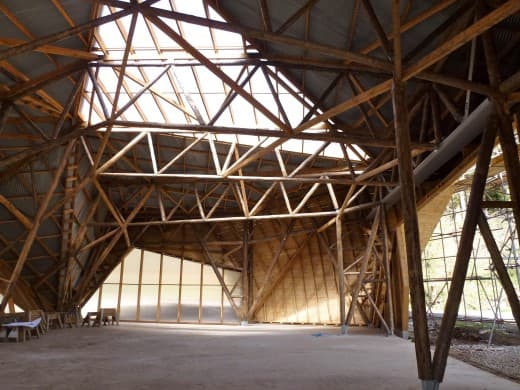
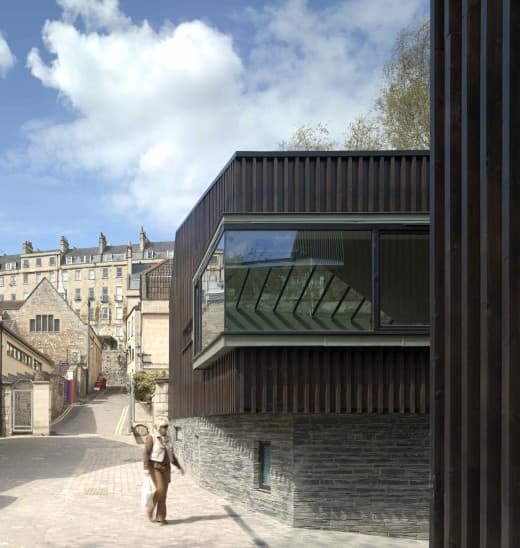 Really pleased that both Hooke Park Big Shed (top) and Stillpoint, Bath (above) have both been shortlisted for regional RIBA Awards
Really pleased that both Hooke Park Big Shed (top) and Stillpoint, Bath (above) have both been shortlisted for regional RIBA Awards
BD – Architects’ Favourite Pubs
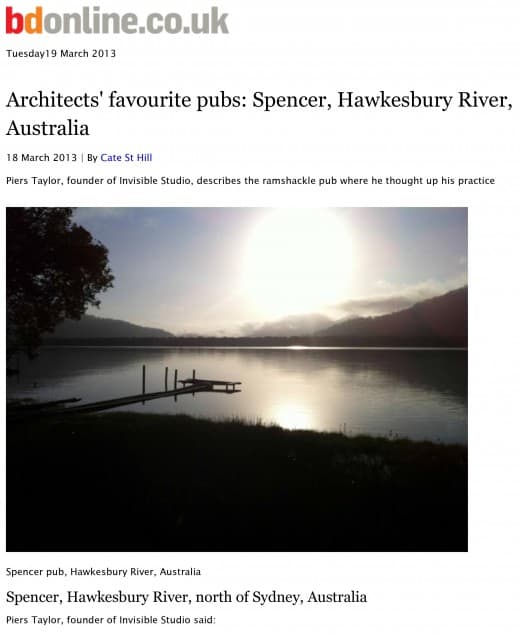 Original article in Building Design HERE
Original article in Building Design HERE
Piers Taylor writes: “My favourite pub is the Pub at Spencer, on the Hawkesbury River, 25 miles or so as the crow flies north of Sydney.
It doesn’t really have a name other than the Pub, and in the strictest terms, it isn’t really a pub. It’s a ‘Bottle Shop’ with a series of ramshackle chairs and only one very large table under the gum tree opposite and a wharf where you tie up your boat.
It’s only really accessible by boat, and of course it’s a badge of pride to arrive in the most battered tinny possible. The other option is a 50 mile twisting road. You buy your grog in the store, and then meander across the road with it. If you phone in advance, they’ll kill a chicken and barbeque it for you. I’ve spent a long time hanging out there, and done a great deal of head scratching there (I probably just needed a nit comb).
As much as the low key and ramshackle charm, there’s an astonishing, quite mesmerising physical beauty. It slaps you in the face makes you quite slack jawed with awe. The river has virgin bushland – unchanged for 50,000 years – that comes down to the water, and a series of mountains as a backdrop. The light changes radically throughout the day – in the morning, it is purple and lime green, and in the evenings an extraordinary orange that burns on the clouds in the distance.
There are pelicans, herons, cockatoos, dingoes, kangaroos, bush turkeys and benign jellyfish the size of dustbin lids. At night, the atmosphere changes again, and feels more than a little dangerous as you become increasingly intoxicated, with strange noises and the odd new arrival emerging from the surrounding pitch black bushland.
It’s a perfect place for just hanging out. I was told about it by my old friend – architect Lindsay Johnson who lives down the river and who is extraordinarily adept at passing time on the water’s edge in his swimmers, stubby in hand. It’s not on any tourist trail, and it’s a place where you meet strange passers by – drifters, travellers, old bush characters – all seemingly living out on the edges. I love that atmosphere. Although it’s geographically close to the city, it feels a million miles from anywhere, and feels like a kind of frontier.
It was there that I dreamt up my practice, there among the cool summer breeze that blows in the afternoons and takes the heat out of the day. There among the winos, the weirdos, the drifters and the hobos. In my mind, the place still represents how a practice could operate.”
Categories
- 100k house
- Articles
- brexit
- Caretaker's House
- Christchurch
- current
- East Quay Watchet
- film
- ghost barn
- Glenn Murcutt
- Heroes
- Hooke Park
- House in an Olive Grove
- Invisible Studio
- longdrop
- Mess Building
- Moonshine
- On the Road Again
- passihvaus
- piers taylor
- piers,taylor
- press
- Projects
- Riverpoint
- Self Build
- Stillpoint
- Studio Build
- Studio in the Woods
- talks
- Trailer
- truss barn
- Uncategorized
- Vernacular Buildings
- watchet
- Westonbirt
Tags
- caretaker's house
- design and make
- Design Build Workshop
- Design Make
- east quay
- east quay watchet
- Glenn Murcutt
- green timber architecture
- Hooke Park
- Hooke Park Big Shed
- Invisible Studio
- Low Impact House
- moonshine
- Onion Collective
- piers taylor
- Piers Taylor Architect
- piers taylor invisible studio
- self build
- self build architect
- Starfall Farm
- Stillpoint Bath
- studio in the woods
- Sustainable Architecture
- The house that £100k built
- timber architecture
- Timber House
- timber workshop
- visible studio
- westonbirt architecture
- westonbirt tree management centre
